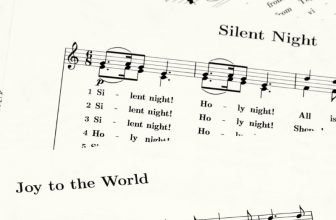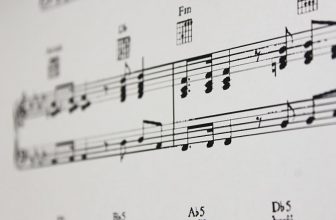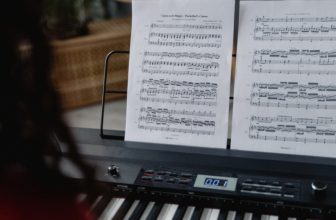What is Strophic Form in Music?

Strophic type musical forms involve taking a single section of music and repeating it one or more times. When listening to the strophic type forms, we hear the same section rearranged in many ways. There are two types of strophic forms: strophic and variation.
The basic strophic form is also known as the AAA form as the A section repeats over in each section of the piece.
Contents
What is Strophic Form?
The strophic form is a form for vocal music. Each section of composition is taken as a musical strophe in this form. Stanzas of text vary based on the theme, strophe by strophe.
You’ll encounter this pattern in works like hymns, folk songs, art songs, and many other genres of music. No matter how complex or simple a hymn or a ballad is, it will almost always be strophic, even if the melody fits well into one of the reverting types.
What is Variation Form?
An instrumental version of the strophic form is called a variation form. This form’s other name is theme and variation form. It involves repeating a musical theme. Usually, in a concluded melody with harmonic accompaniment, but each time varying the melody.
In this article, I’ll start by reflecting on the strophic form in both its simple and modified forms. But before all, I want you to remember what musical form is.
Musical Form
Musical form is the basic plan for how to write a melody, rhythm, harmony, and phrasal in a specific sectional pattern without getting lost in different ideas. In music, there are four basic types of form:
The Iterative Type: an initial melodic line that played over and over again.
The Reverting Type: the principal melodic line is reintroduced following a contrasting phrase.
The Strophic Type: a single section that continually transforms into multiple versions.
Progressive Music: Constant introduction of new musical material.
Examples of Strophic Type Forms
Repetition of the main theme with changes is the common feature of strophic and variation forms of compositions. The main difference between them is the degree to which the repeats are altered in at least one and several different ways. I want to explain the different types of strophic forms with examples that you can find and listen to.
Strophic Form
Strophic form is a way to compose the repetition of one section at various times in vocal music. There are two different ways to compose in this form. These two types are:
1. Simple Strophic
The music in each strophe of a simple strophic work is similar. Although there may be minor changes in the melody and rhythm, the first section of the song stays the same and repeats one or more times:
The basic strophic A A A form is the simple strophic form. The other versions are developed based on the simple strophic form.
In popular music, the simple strophic form takes place with different names. One-part song form, chorus form, or verse-repeating form.
Examples
Amazing Grace – John Newton
The Times They Are A-Changin’ – Bob Dylan
2. Modified Strophic
The modified strophic form may include a reharmonization, an enlargement of a phrase, or a new section. It can even include a whole new strophe without losing the main characteristics of the A section.
You still have an AAA form, but this time each section has slight differences. In this way, you have the feeling that the same section repeats over and over though you hear little changes.
The modifications of the modified strophic form are indicated with one or more apostrophe marks: A A’ A’’
Examples
Blue Suede Shoes – Carl Perkins
House of the Rising Sun – The Animals
Variation Form
Variation form is the process of transforming a musical theme through a sequence of variations. Here, the repetitions of the first theme come with serious changes. Still, you hear some characteristics of the theme in these variated sections.
There are two types of variation forms:
1. Continuous Variation
Continuous variation introduces a brief theme that concludes on a 5th (dominant) chord, especially in Baroque period works. Without a pause or break between, the same short theme is replayed.
Another name for this form is ostinato variations. The continuous variation form is mostly used in Baroque music. It has three subtypes called ground bass in which the bassline is repeated over and over. Chaconne, in which chord progression is repeated. And passacaglia in which the line is repeated with the possibility to move from melody to back voices through the chords to bass.
In time, the ostinato form developed and you can find examples in jazz, blues, rock, and similar genres.
Examples
Funky Drummer – James Brown
Superstition – Stevie Wonder
2. Sectional Variation
Themes are longer than those of continuous variations, usually containing more than one phrase. It might be a period or a binary structure. Each variation of the theme is tonally-closed. Each variation starts in a key and ends in that same key but with the V-I (authentic) cadence. You can also call it theme and variations form.
It became popular in the Classical era. The sectional variation form is used in many different genres like the continuous form.
The AABA is a song form developed based on the sectional variation form by adding a bridge before the last variation. You can find many different types with examples. It is known as a 32-bar song form in the meantime.
Examples
I Want to Hold Your Hand – The Beatles
Every Breath – The Police (Extended type AABA)
Summary
The strophic form is a great way to create vocal music, as it allows for the text to be varied strophe by strophe. This form is also found in instrumental music, in the variation form. This type of form involves repeating a musical theme. Usually, in a concluded melody with harmonic accompaniment, but each time varying the melody. This is a great way to create an interesting piece of music that listeners will enjoy.





